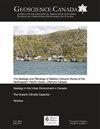Hutchison Medallist 1. Wave-Dominated to Tide-Dominated Coastal Systems: A Unifying Model for Tidal Shorefaces and Refinement of the Coastal- Environments Classification Scheme
IF 0.8
4区 地球科学
Q3 GEOSCIENCES, MULTIDISCIPLINARY
引用次数: 11
Abstract
Coastal depositional systems are normally classified based on the relative input of wave, tide, and river processes. While wave- through to river-dominated environments are well characterized, environments along the wave-to-tide continuum are relatively poorly understood and this limits the reliability and utility of coastal classification schemes. Two tidal shoreface models, open-coast tidal flats (OCTF) and tidally modulated shorefaces (TMS), have been introduced for mixed wave-tide coastal settings. Following nearly two decades of research on tidal shorefaces, a number of significant insights have been derived, and these data are used here to develop a unified model for such systems. First, OCTFs are components of larger depositional environments, and in multiple published examples, OCTFs overlie offshore to lower shoreface successions that are similar to TMS. Consequently, we combine OCTFs and TMSs into a single tidal shoreface model where TMS (as originally described) and TMS-OCTF successions are considered as variants along the wave-tide continuum. Second, tidal shoreface successions are preferentially preserved in low- to moderate-wave energy environments and in progradational to aggradational systems. It is probably difficult to distinguish tidal shorefaces from their storm-dominated counterparts. Third, tidal shorefaces, including both TMSs and OCTFs, should exhibit tidally modulated storm deposits, reflecting variation in storm-wave energy at the sea floor resulting from the rising and falling tide. They may also exhibit interbedding of tidally generated structures (e.g. double mud drapes or bidirectional current ripples), deposited under fairweather conditions, and storm deposits (e.g. hummocky cross-stratification) through the lower shoreface and possibly into the upper shoreface.The development of the tidal shoreface model sheds light on the limitations of the presently accepted wave-tide-river classification scheme of coastal environments and a revised scheme is presented. In particular, tidal flats are components of larger depositional systems and can be identified in the rock record only in settings where intertidal and supratidal deposits are preserved; consequently, they should not represent the tide-dominated end-member of coastal systems. Instead, we suggest that tide-dominated embayments should occupy this apex. Tide-dominated embayments exhibit limited wave and river influence and include a wide range of geomorphological features typically associated with tidal processes, including tidal channels, bars and flats.和记黄埔奖牌获得者波浪主导到潮汐主导的海岸系统:潮汐岸面的统一模型和海岸环境分类方案的改进
海岸沉积体系通常根据波浪、潮汐和河流过程的相对输入进行分类。虽然波浪到河流主导的环境具有很好的特征,但对波浪到潮汐连续体的环境了解相对较少,这限制了海岸分类方案的可靠性和实用性。针对混合波潮海岸环境,引入了两种潮汐海岸面模型,即开放海岸潮坪(OCTF)和潮汐调制海岸面(TMS)。经过近20年对潮汐海岸面的研究,已经得出了许多重要的见解,这些数据被用于开发此类系统的统一模型。首先,OCTF是较大沉积环境的组成部分,在多个已发表的例子中,OCTF覆盖了类似于TMS的近海到下滨面序列。因此,我们将OCTF和TMS组合成一个单一的潮汐海岸面模型,其中TMS(如最初所述)和TMS-OCTF序列被视为沿波潮连续体的变体。其次,潮汐滨面序列优先保存在低到中等波浪能环境中以及前积-加积系统中。可能很难将潮汐海岸面与风暴主导的海岸面区分开来。第三,潮汐滨面,包括TMS和OCTF,应该表现出潮汐调节的风暴沉积物,反映出潮汐上升和下降导致的海底风暴波能量的变化。它们还可能表现出潮汐生成结构(如双泥幕或双向海流波纹)的互层,这些结构在晴朗天气条件下沉积,以及风暴沉积物(如丘状交叉分层)穿过下海岸面并可能进入上海岸面。潮汐海岸面模型的发展揭示了目前公认的波浪潮河流海岸环境分类方案的局限性,并提出了一个修订方案。特别是,潮坪是较大沉积体系的组成部分,只有在潮间带和潮上带沉积物保存的环境中才能在岩石记录中识别;因此,它们不应该代表沿海系统中潮汐主导的末端成员。相反,我们建议潮汐主导的海湾应该占据这个顶点。潮汐主导的海湾表现出有限的波浪和河流影响,并包括通常与潮汐过程相关的广泛地貌特征,包括潮道、坝和滩。
本文章由计算机程序翻译,如有差异,请以英文原文为准。
求助全文
约1分钟内获得全文
求助全文
来源期刊

Geoscience Canada
地学-地球科学综合
CiteScore
3.30
自引率
0.00%
发文量
9
审稿时长
>12 weeks
期刊介绍:
Established in 1974, Geoscience Canada is the main technical publication of the Geological Association of Canada (GAC). We are a quarterly journal that emphasizes diversity of material, and also the presentation of informative technical articles that can be understood not only by specialist research workers, but by non-specialists in other branches of the Earth Sciences. We aim to be a journal that you want to read, and which will leave you better informed, rather than more confused.
 求助内容:
求助内容: 应助结果提醒方式:
应助结果提醒方式:


